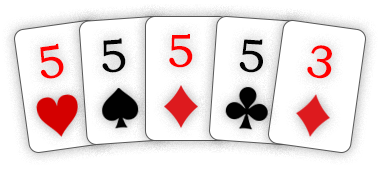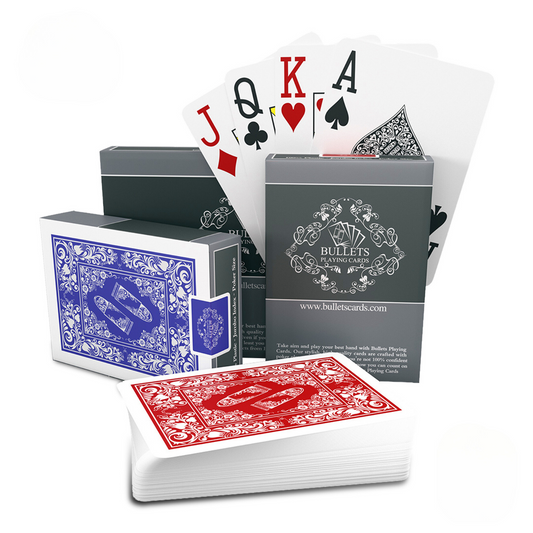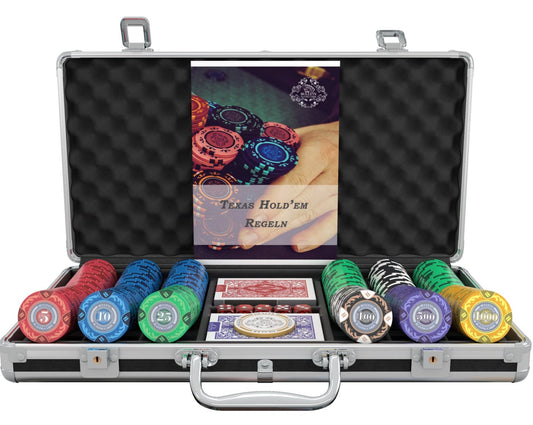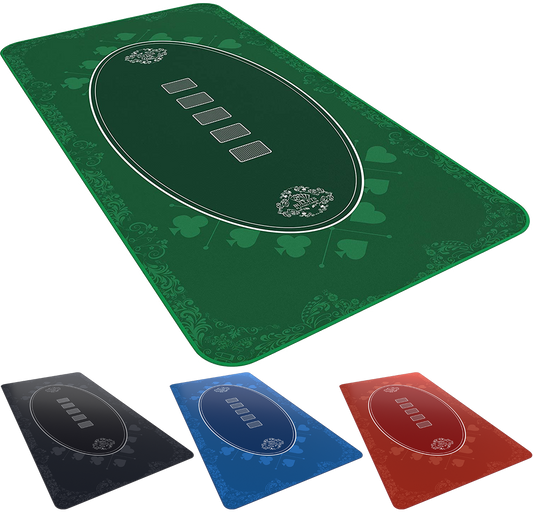Poker rules
TEXAS HOLD'EM
Poker is a board game that can be played with a minimum of 2 players. A maximum of 10 players usually play at a table at the same time. Players continuously play one game round ("hand") after the other and the game lasts for as long as the participants specify (preferably at the beginning) or until one player has acquired all the chips (eg tournament).
There are two basic variants of Texas Hold'em Poker: No Limit Hold'em and Limit Hold'em. The difference is that in the Limit variant the amount of the bet is limited. In the end, this leads to a quieter game, because the money changes hands more slowly. With No-Limit Hold'em, however, exciting situations occur more often.
| Tip: In No-Limit Hold 'em, if you play with a low minimum bet and don't raise it during the course of the evening, you can have a long poker night even with this variation. |

| 1. Game preparation | 4. The Betting Round (Check, Fold, Bet) |
| 2. The Game Round (Flop, Turn, River) | 5. Peculiarities of All-In |
| 3. Poker hands |
1. Game preparation
First of all, the framework conditions should either be determined by the game organizer or agreed jointly. The following points should be taken into account:
Tournament or cash game: In a tournament, everyone starts at the same time with the same amount of chips in return for the buy-in and after a so-called optional re-buy phase, in which players can buy in again, the winner is determined using the well-known KO system. However, if you arrange to meet up with friends for a cozy evening of poker, this mode has the disadvantage that players who are leaving will wait until the game ends, which can sometimes take longer.
Therefore, we recommend one, adapted to your own needs, cash game mode: You set the start and end times in advance. Late players can easily buy in, for example, at the initially fixed buy-in amount and players who want to leave early should announce this in advance.
the end of the game: It should be clear to everyone in advance when the game will end. Unless you're playing a tournament where the game ends when one player has all the chips, you should set an end time in advance. (If you want to keep the end of the game variable, it can happen that the chip leader would rather end the game immediately and the player who lost the most would rather have more time to play back the loss and that holds potential for tension).
Buy-in: Determines how high the amount should be that a player has to pay in advance to take part in the poker round or whether you want to play for free. Decide whether you want to allow a player to re-buy once they lose all their chips or fall below a certain point (“re-buy”) and how much they can re-buy can shop.
| Tip: WIf you want to keep the odds fair, it makes sense to set the same amount for a re-buy as for the buy-in. |
Minimum bet: In addition, a minimum bet must be determined before the start of the game that a player must place at least if he has decided to place a bet (“Big Blind”) and whether and how this should increase over the course of the game.
| Tip: Experience has shown that a low minimum bet is recommended at the beginning. In a game with chips worth 1000 points per player, a minimum bet of 10 points is initially sufficient. |
The minimum bet can be increased in the course of the game evening (e.g. after x minutes or after x game rounds) if the players have agreed on this before the start of the game. However, the increase only applies to the next game round ("hand") and is never introduced within a current game round.
Each player now receives a stack of chips ("Chip Stack"), the denomination of which should be the same for each player and which corresponds to the value of the buy-in for games with money in cash game mode. The chips must remain on the table throughout the game and may not be pocketed at any time.
Place cards: Find cards from the deck so that you have an ascending order (eg A-2-3-4-5- […]) with so many cards that there is one for each player. Determines which seat should be assigned the lowest card. The next higher card is assigned to the space to the left and then clockwise so on. Shuffle the cards you selected and place them face down on the table. The players each draw a card and take the space assigned by it.
2. The game round
An Game round of Texas Hold'em Poker is divided into 4 phases in which cards are dealt or revealed and in each of which bets can be made:
- Players only have two cards in hand and there are no community cards (Pre-flop).
- There are three community cards (apply to all players) revealed (Flop)
- Another community card is revealed (Turn)
- Another community card is revealed (Rivers)

Overview:
At the beginning of each game round, each player receives two cards in hand by the card-giving player (dealer) after he has shuffled the cards well. The cards are only shuffled again after the round has been completed.
Each player should always keep the cards in hand secret until the end of a game round, so as not to give the other players an advantage.
Hand out: First the dealer deals a card to the player to his left and then to the next player clockwise until he is the last player in the round to deal a card to himself. Then he repeats the whole thing so that each player has two hand cards.
In the further course of a round there will be five Community cards in the middle of the table, which apply to everyone and with which each player secretly combines his face-down cards in the best possible way. The best combination of cards - consisting of five cards - that a player can achieve by combining the hand cards with the community cards is a player's poker hand. It is irrelevant how many cards are combined with the community cards (whether both, only one or none at all).
| Example: For example, if someone has a 7 and a 2 in hand and the community cards are a straight of 9-K, the player's hand is a straight of 9-K. If another player had an ace in hand, that player would have a higher straight of 10-A. |
In detail:
There is one in each of the four phases mentioned at the beginning Betting round (No. 4). After the hand cards have been dealt, the first betting round takes place, which is slightly different from the other betting rounds. The other three betting rounds follow each time the next community card (s) are revealed.
Reveal community cards: The dealer reveals the flop after the first round of betting (see above), whereby he first takes the top card of the pile and discards it face down ("burns") and only then puts the next three cards face up in the middle of the table. After another round of betting, the dealer burns the top card again and reveals the next card (turn). Another betting round is played and the dealer proceeds on the next community card (river) in the same way as on the turn. Then the last round of betting can take place.
An Game round ends at the latest when the remaining players have matched their stakes with the highest after the last betting round. The remaining players reveal their hand cards, starting with the player who last raised (“showdown”). If no one raised, the first player to the left of the dealer reveals his cards.
The game round can also end prematurely if all but one player have dropped out.
The Jar goes to the winner of a game round. Gewinner a game round is:
- in a showdown, the player with the highest hand
- when everyone else has cast: the last player remaining. He doesn't have to reveal his hand cards, but can do so if he wants.
- if two or more players have the same hand at a showdown, which is also the highest: All players who have the same hand have won. The pot is split between these players ("Split Pot").
Next Start of a new game round all cards are shuffled again and the dealer is now the player to the left of the previous dealer, he is also the one who shuffles the cards. The dealer moves clockwise after each game round.
| We recommend, to use the dealer button (white chip labeled with the word dealer) continuously in the game: it is placed on the table in front of the dealer so that other players can identify him. |
3. Poker hands
The poker hands shown below (also called "pictures" or "leaves") every player should know by heart (shown on the next page in ascending order).
 |
High Card: None of the following images could be obtained. - The highest card counts. |
 |
Pair: Two cards of the same rank. |
 |
Two couples: Two different couples. |
 |
Triplet: Three cards of the same value. |
 |
Street: Five cards consecutive by value; the ace counts as "1" before the 2 or follows the king. |
 |
Flush: Five cards all of the same suit. |
 |
Full House: Three of a kind and a pair. |
 |
Quadruplets: Four cards of the same rank. |
 |
Straight flush: A street where all cards are of the same suit. |
 |
Royal Flush: The highest street (10-A) where all cards are of the same suit. |
If two or more players have the same picture, then the card values decide. The following situations can arise:
- In the event of a tie between two players (both have the same picture), the winner is whoever has the same picture with higher card values.
| Example: Two players have a street. One has a straight from 4-8 and the other has a straight from 5-9. The player with the straight 5-9 wins. |
- If the card values of the pictures also match, then the additional cards in the hand decide.
- If two or more players have the best combination of all five cards having the same value, then each of these players wins equally (split pot).
4. The betting round
Basics
- Starting player: In each betting round the player sitting to the left of the dealer begins and then it continues clockwise. The dealer is always the last one to move (exception in the pre-flop).
- Use: A player is never forced to make a bet (exception: "blinds" in pre-flop). Did you make a bet (Push chips into the middle or name the bet amount), it cannot be withdrawn, but is placed in the middle of the table in the so-called "pot" that the winner of a game round receives.
- clarity: Until the end of a round of betting (revealing a new community card or showdown) you can let each player's bets stand in front of them and only when all betting decisions of the round have been made are all bets combined and added to the pot.
Pre-flop
The betting round in the pre-flop differs from the other betting rounds:
- The players must - if they do not want to fold already here - place a bet, although they only know their hand cards and do not yet have a complete hand (“blind”).
- The two players to the left of the dealer must always place a bet in this phase, regardless of whether they want to play this game at all. The first player to the left of the dealer only has to place half of the minimum bet ("small blind") and the second player has to place the full minimum bet ("big blind"). Both are not allowed to bet a higher amount at this time. Only when the dealer has made his move, the players with the small and big blind are allowed to make their move, i.e. to take one of the five actions listed below.
During this phase, it is not the dealer who has the last move, but the player who had to post the big blind.
Options for action
The active player basically has three options for action: Push ("Check"), Discard ("Fold") or Set ("Bet"). When placing a bet, a distinction is made between going with ("call") and raising ("raise").
- Slide (“Check”) - The player does nothing and it is the next player's turn. (Can also be identified by knocking on the table). This is only possible if no bet or raise has previously been made by any player in the betting round. If he is the last player in the betting round, the round ends.
- Lay down ("Fold") - The player refuses to place a bet and puts his cards face down. He can no longer participate in the following betting rounds of this game round and can no longer win the pot. Any previously placed bets remain in the pot and are lost for the discarding player.
- Set (or Wetten or "Bet") - The player places a bet that must be at least equal to the amount of the predetermined minimum bet (big blind). In the no-limit variant, the maximum bet size is only limited by the number of chips he has on the table in front of him at the time of the betting decision. If he bets everything, it's called "all-in". If a player does not have enough to meet the minimum bet, they must go all-in if they wish to place a bet. If another player has already made a bet in the betting round, there are - if you don't want to fold - the options of going with ("call") or raising ("raise"), whereby the repeated raising ( "Re-raise") is shown:
- Go along (“Call”) – The player bets an amount equal to the last bet made, or matches his previous bet if other players have raised.
- Increase ("Raise") - The player raises a previous bet by at least the amount of the previous bet Increase.
| Example: The first player A bets x (e.g. 10 points, ie raised from 0 to 10); Player B must increase the first bet x (10 points) by at least x (also 10), i.e. bet a total of z=x+x (10+10=20 points) for the increase to be valid. |
- Re-raise: After a raise by a player, any player still in the round may re-raise, with the most recent raise being the minimum re-raise.
| Example: In the above case, B increases the first bet x (10 points) by more than the minimum raise (eg 14 points), so he bets a total of 24 points and player C would have to have at least 24+14=38 points to re-raise the previous raise set. |
An Betting round ends in the following cases:
- All players have adjusted their stakes to the highest bet in the round or have dropped out.
- All players push. As soon as the last player has checked (the dealer or the big blind, depending on the phase of the game), the round is over without a bet being made.
- All players but one discard their cards. In this case, both the betting round and the game round are over.
5. Peculiarities of All-In
When a player goes all-in, he bets all the chips he has available. The player who goes all-in can only win as many chips from another player as he was able to bet in the game round.
| Example: A goes all-in after the flop with 50 points and has previously posted a total of 20 points in blinds (a total of 70 points). B bets 120 points (+20 blind = 140 points) and C calls. A can win 70 points each from B and C's bets (140 points in total). The total amount that A gets paid out if he should win is 210 points (he also gets his own stake). |

The rest of the game depends on whether more than one player calls the all-in amount or only one player calls the amount:
Only one player calls: The betting round is over. If a calling player has bet more than the all-in amount (eg to scare off other players), he can take back the amount that exceeds the all-in after the last player has been eliminated. Since no further bets can be made, the players already open their hand cards and the dealer gradually reveals all community cards according to the rules.
More than one player calls the all-in: A so-called "side pot" is formed, which corresponds to the maximum amount that the all-in player could win (So in the above example 210 points). The other players continue playing the round as normal. Bets that the all-in player cannot win because they exceed the all-in amount and all bets made thereafter are collected in a second side pot. The second side pot can only be won by other players who can continue to place bets.
So if the all-in player has the highest hand at the showdown, he wins the side pot, which he could win at most. The player with the second highest hand wins the other side pot. If another player has the highest hand (even higher than the all-in player), he gets both side pots, i.e. everything.




